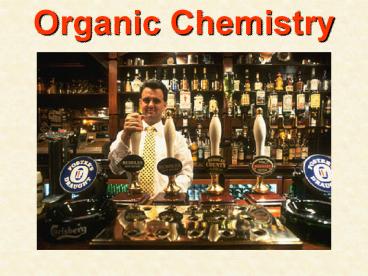Organic Chemistry - PowerPoint PPT Presentation
Title: Organic Chemistry
1
Organic Chemistry
2
Organic Compounds
- Compounds that have
- Carbon atoms bonded to each other and to
hydrogen, oxygen, nitrogen, sulfur, phosphorous,
chlorine OR fluorine - COVALENT BONDS
- Can be natural (ex. sugar) or synthetic (ex.
plastic)
3
Organic molecules
- All contain CARBON
- Can covalently bond w/ 4 other atoms
- Holds electrons
tightly forms
STRONG BONDS
4
Chemical Composition
- Living organisms
50-95 water - The rest CHNOPS
- Less than 1/2 vital ions
- Ca2, Na, Mg2, etc.
5
4 Major Groups of Organic Molecules Essential to
Living Things
6
Carbohydrates (sugars)
- (CH2O)(2-8) basic formula
- Simple sugars quick energy source
- Glucose, fructose
- Form rings when in water
7
Disaccharides
- Transport molecules
- Sucrose (sap in plants)
- Lactose, Maltose
8
Polysaccharides
- Storage (starches)
- Structural support (cellulose, chitin)
9
Monomers to Polymers
- Condensation links single units
- Saves space
- Hydrolysis breaks chains apart
- Releases energy
10
Saccharide Formation
- Condensation links monosaccharides
11
Starches
- Main storage molecules in plants
- Chains of simple sugars that must be broken
down before they can be used
12
Glycogen
- Main storage molecule in animals
- Stored in muscles
- Broken down when glucose is no longer available
13
Lipids (fats, oils, and waxes)
- LONG hydrocarbon chains, that are insoluble in
water (nonpolar) - Fats store energy 6 times better than starch,
carry more energy-rich bonds
Fatty acid - carbon chain carboxyl unit
14
Fats
- Glycerol
- 3 fatty acids
- Joined by conden-sation
15
Saturated Vs. Unsaturated
- Saturated single bonds ONLY in carbon chain
- Carbons saturated w/ hydrogen
- Unsaturated double or triple bonds
Unsaturated
Saturated
16
Blubber
- Fats that DON'T get converted
- Vital as an insulating layer
- Fats around
organs arent
converted - Shock
absorbers
17
Steroids
- Cholesterol (saturated)
- Parent molecule of many steriods
18
Proteins
- Can form enzymes
- Act as organic catalysts
- Allow reactions to occur in living bodies at
safe temperatures
19
Nucleotides (DNA, RNA)
- Nitrogenous base sugar phosphate molecule
- Form the code of life
20
Organic Compounds
- Carbohydrates
- Monosaccharides ? Disaccharides ?
Polysaccharides (Condensation Reaction) - Lipids
- Fats, Oils, Waxes
- (Saturated vs. Unsaturated)
- Proteins
- Chains of Amino Acids (20 different amino acids)
- Enzymes
- Nucleic Acids
- DNA (Deoxyribonucleic Acid) RNA (Ribonucleic
Acid) - Nucleotides (Sugar, Phosphate, Base)































